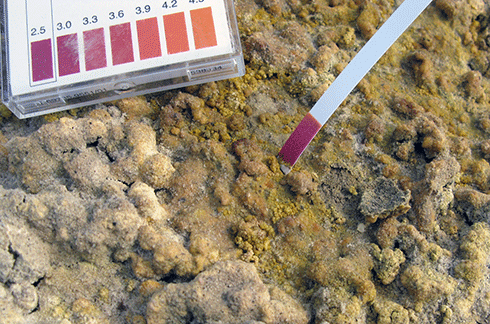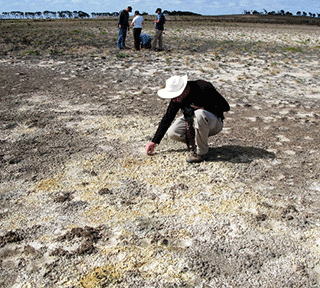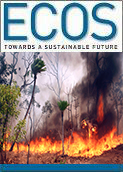
|
Published: 27 October 2014
From wetlands to wasteland: it's not just oceans that can turn acidic
Around 2007–2009, at the end of the Millennium Drought, large areas of the lower Murray–Darling Basin in South Australia had slowly turned from fertile, irrigated farmland and ecologically diverse wetlands into dried out wastelands of cracked soil and mud.
The soil in much of this area contains iron sulfide minerals. While submerged, this sulfidic mud was harmless. But, during the drought, the area was exposed to oxygen in the air for the first time in more than 100 years. The sulfide in the soil reacted with the oxygen in the air, forming sulfuric acid.
The resultant soils, known as acid sulfate soils with sulfuric material, have a pH of less than 4, and can be as low as 1.6 in some areas – almost as strong as car battery acid.1 Nothing can survive in soils like these.
Joanne and Barry Pfeiffers were among the many farmers badly hit by the drought in South Australia’s Lower Murray Irrigation Area – an area underlain with acid sulfate soils. With their irrigation entitlements cut and unable to keep their paddocks watered, the Pfeiffers’ once-profitable dairy farm just dried out.
‘The soil cracked, all of our irrigation infrastructure destabilised and fell over – pretty much all of our 84 hectares was totally destroyed,’ Mrs Pfeiffers recalls.
‘We are talking about cracking to at least 1200 mm deep and up to 600 mm wide. You couldn’t drive a four-wheel motorbike down there, you couldn’t even get a tractor in. We even lost about 35 cows that fell in the holes and injured themselves.’
In wetland areas, previously submerged lake beds in the Lower Lakes, including around Lake Alexandrina and Lake Albert, were completely exposed. Several Ramsar-listed and many other wetlands became dry and lifeless.
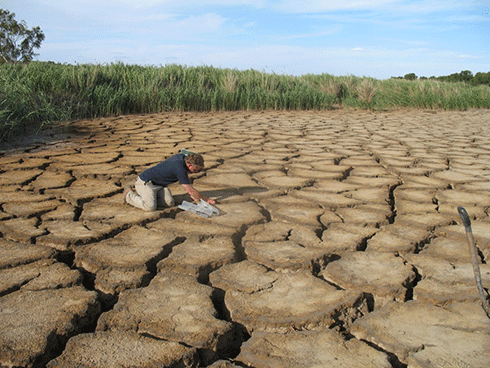
|
|
Once a vibrant wetland, Jury Swamp – which lies in the Lower Murray between Mannum and Murray Bridge –is now a cracked wasteland of sulfuric acid soil. Credit: Rob Fitzpatrick, CSIRO
|
The drought itself was hard enough for both farmers and the natural environment to cope with. But, once these soils became wet again, another problem surfaced. The acids contained in the soils acidified the water, and heavy metals – including aluminium, iron and arsenic, which were previously immobilised in the mud – dissolved in the water to form a toxic soup.
‘We were unaware of the significance of what was happening below our metre of top soil until we started to water again,’ says Mrs Pfeiffers. ‘Water came across the paddocks, and all of a sudden it was orange.’
It wasn’t only farmland and wetlands that were affected. The toxic water also threatened to potentially contaminate Adelaide’s drinking water supply.
Professor Rob Fitzpatrick, Director of the Acid Sulfate Soil Centre at the University of Adelaide, says it was just lucky that when the drought broke, it broke in a big way.
‘We fortunately had two significant floods come through that covered the whole area in the lower Murray,’ he says. ‘If just a little bit of water came down, then that water would have stayed acidic. But more water came down and filled the whole area up, so it diluted the acid and metals in the water...we were very lucky.’
However, while the area now looks okay on the surface, the problem hasn’t gone away. Sitting beneath the water, the acid soil remains in several areas. But now, the soil has no or little buffering capacity – in other words, little ability to keep the pH level stable.
‘Before, the soils had substantial buffering capacity to acidification, because they contained calcium carbonates,’ explains Prof. Fitzpatrick.
The calcium carbonates were derived from carbonate fragments formed in soils (e.g. calcrete) and from shells. Now, these minerals have been destroyed by the acidity, and cannot reform quickly.
This means that when the next drought comes along, the now-degraded soils will become even more acidic, and to a greater depth. And, it seems that another drought could be heading our way sooner rather than later.
‘We’ve started to see a return of a Millennium Drought signature in rainfall,’ says Dr David Jones, Manager of Climate Monitoring and Prediction at the Bureau of Meteorology.
‘The last few years, more often than not, we’ve had below average rainfall, [and] we are heading for yet another below-average rainfall year in southern Australia.’
After the soils have been re-exposed, then what happens when the second drought breaks? The same problem arises – but on a much bigger scale.
‘When these soils are subsequently rewet, a greater volume of water would then become even more acidic, and there’s going to be a much bigger problem,’ says Prof. Fitzpatrick.
So what can be done?
Making sure that water stays in the river and the lakes is one part of it, according to Prof. Fitzpatrick. He’s also been involved in trialling water acidification treatment in wetlands by applying lime. The South Australian Government, along with CSIRO, Flinders University and the University of Adelaide, collaborated in a project that flew hundreds of tonnes of fine limestone into acidic waters of the Lower Lakes in 2010, during the height of the reflooding.
After several months, the limestone had neutralised the acidic water and reduced the concentration of dissolved toxic metals. However, the soils are still acidic today, with the researchers estimating that full recovery could take decades or even longer.
But, by having neutralised the surface water, the scientists hope to have triggered microbial processes that might one day again support aquatic life.
Prof. Fitzpatrick notes that reintroducing phragmites reeds – the type found in marshlands all over the world – might help rehabilitate some of the area’s devastated farmland. He is also leading a project to map the extent of acid sulfate soils, which are found in many areas of Australia, not just the lower Murray. This will result in a web-based hazard assessment tool aims to help farmers and land managers identify areas of concern.
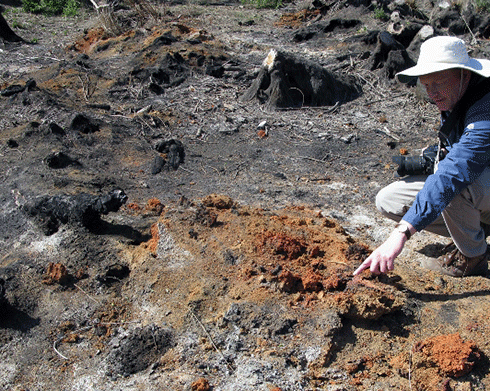
|
|
Dr Shand points out areas of burnt sulfidic material in Jury Swamp soil, which has formed red brick-like fragments. Credit: Rob Fitzpatrick, CSIRO
|
While recovery from water acidification is possible – even though it may take decades or even hundreds of years – there’s a darker side to acid soils in our drying climate.
In the lower Murray, Mussel Lagoon and Jury Swamp became so dry that during a bushfire, the extreme temperatures actually melted and fused the soil into brick-like fragment. The soil was changed forever in a completely irreversible process.
Can such an area ever be rehabilitated?
‘I’m not saying you’ll never [rehabilitate],’ says Prof. Fitzpatrick, who was involved in a study of the swamp’s dramatic soil transformation. ‘But, there is now less friable and fertile soil in that wetland, because of the abundance of hard brick-like fragments.
‘With time, though, it is possible to grow wetland plants there.’
1 In chemistry, pH is a measure, on a scale of 1-14, of the acid or basic nature of an aqueous solution. Solutions with a pH less than 7 are said to be acidic; solutions with a pH greater than 7 are basic or alkaline. Pure water has a pH close to 7.


